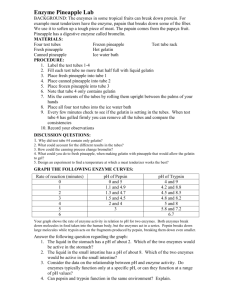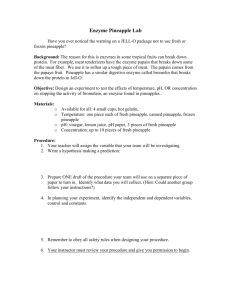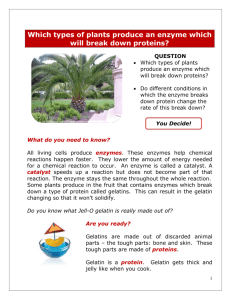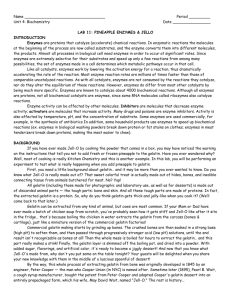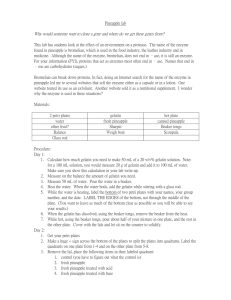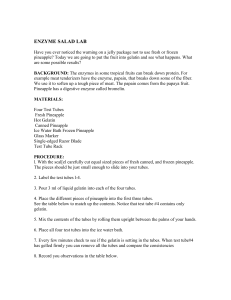Enzyme spec 20 Lab
advertisement
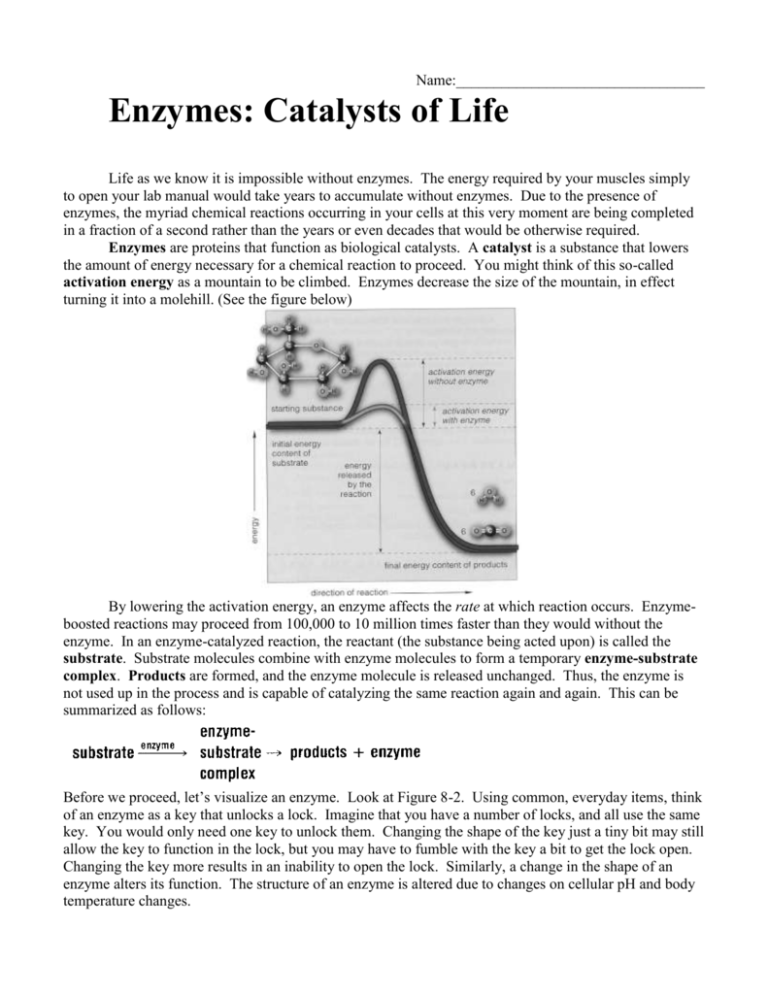
Name:_________________________________ Enzymes: Catalysts of Life Life as we know it is impossible without enzymes. The energy required by your muscles simply to open your lab manual would take years to accumulate without enzymes. Due to the presence of enzymes, the myriad chemical reactions occurring in your cells at this very moment are being completed in a fraction of a second rather than the years or even decades that would be otherwise required. Enzymes are proteins that function as biological catalysts. A catalyst is a substance that lowers the amount of energy necessary for a chemical reaction to proceed. You might think of this so-called activation energy as a mountain to be climbed. Enzymes decrease the size of the mountain, in effect turning it into a molehill. (See the figure below) By lowering the activation energy, an enzyme affects the rate at which reaction occurs. Enzymeboosted reactions may proceed from 100,000 to 10 million times faster than they would without the enzyme. In an enzyme-catalyzed reaction, the reactant (the substance being acted upon) is called the substrate. Substrate molecules combine with enzyme molecules to form a temporary enzyme-substrate complex. Products are formed, and the enzyme molecule is released unchanged. Thus, the enzyme is not used up in the process and is capable of catalyzing the same reaction again and again. This can be summarized as follows: Before we proceed, let’s visualize an enzyme. Look at Figure 8-2. Using common, everyday items, think of an enzyme as a key that unlocks a lock. Imagine that you have a number of locks, and all use the same key. You would only need one key to unlock them. Changing the shape of the key just a tiny bit may still allow the key to function in the lock, but you may have to fumble with the key a bit to get the lock open. Changing the key more results in an inability to open the lock. Similarly, a change in the shape of an enzyme alters its function. The structure of an enzyme is altered due to changes on cellular pH and body temperature changes. Proteases are enzymes commonly found in the supermarket, such as contact cleaner and meat tenderizer. As their name suggests, proteases are enzymes with the specific ability to break up proteins into smaller polypeptides. Major digestive proteases in humans are pepsin, trypsin, and chymotrypsin. Pepsin is found in the stomach of animals and helps begin the digestion of meat, fish, cheese, and other ingested proteins. Digestion of ingested proteins in our stomach and small intestines releases individual amino acids to the blood stream for other metabolic processes including synthesis of our required proteins. Proteases digest various proteins in all organisms including plants. Plant proteases of particular interest are found in tropical plants such as papaya and pineapple. Proteases are used commercially in some soaps, stain removers, carpet cleaners, and detergents to dissolve protein stains such as grass and bloodstains. The most abundant commercially available protease is papain extracted from papaya plants. Papain is used in most meat tenderizers and in some contact lens cleaners. In this activity we will compare different proteases ability to digest jello gelatin proteins. Gelatin is extracted from dead animal skin and bones as collagenous material, which is then treated to produce the final gelatin. Gelatin has a unique sequence of amino acids which bind to form a repeating sequence of the triplet glycine-proline-hyroxyproline, which gives gelatin its triple helical structure. This helical structure is responsible for trapping water molecules and forming gels. Materials: Cranberry Jello Canned Pineapple Juice Fresh Pineapple Distilled Water Teacher Notes: The day before the lab, the jello needs to be made. Boiled pineapple juice and frozen pineapple juice are made from fresh pineapple juice, then boiled or frozen. You may need to warm up your spectrophotometer as much as 24 hours prior to the lab. Instructions: (Work in groups of 2-4) To determine the activity of proteases, you will measure the release of color from the solid gel. When solidified cranberry gelatin is digested by proteases, a red color is liberated from the gelatin structure and released into the solution. 1. Obtain a 50 mL beaker and place small piece of fresh red cranberry gelatin (stamped out with a small test tube) in the bottom of the beaker. 2. Add 15 mL of distilled water. 3. Then your teacher will assign you to test one of the following enzymes or control: _____ Control: add 2 mL of DI water to your beaker. _____ Canned Pineapple: add 2 mL of pineapple juice (1g in 10 mL DI). _____ Fresh Pineapple: add 2 mL of pineapple juice (2 tablets in 10 mL DI). _____ Boiled Pineapple: add 2 mL of pineapple juice. (Filtered & diluted 2 to 1 with DI) _____ Frozen Pineapple: add 2 mL of pineapple juice. (Filtered & diluted 2 to 1 with DI) 4. Every 5 minutes mix the solution by swirling the gelatin-containing beakers. 5. Pour off around 4 mL of this swirled solution into a spectrophotometer tube. Be careful NOT to smudge, scratch, or break your cuvette, the tube that goes into the spectrophotometer. Fingerprints will affect your results, wipe them clean with lens or tissue paper, NOT paper towel! When taking reading always place the white mark on the cuvette in the same direction. How a Spec 20 Works: The spectronic 20 spectrophotometer is an instrument that uses a beam of light to measure transmittance and/or absorbance of solutions. The light is sent through a moveable grating, allowing specific wavelengths of light to be selected (500 nm in this case) and passed through the sample. A phototube on the other side of the cuvette measures the amount of light that has passed through the sample and produces an electrical signal. The strength of the signal can be directly observed on the meter. In this experiment, the starting solution will be clear, allowing nearly 100% of light to be transmitted through the sample tube. If the enzyme produces the product, the sample will darken, permitting less light to be transmitted through the cuvette. The change in transmittance will be directly proportional to the amount of product. If the transmittance readings are recorded over time, the rate of the enzymatic reaction can be calculated. 6. Measure the absorbance of your solution at 500 nm and record your results below. 7. Immediately pour back the solution into your beaker. 8. Repeat your measurements every five minutes for a total of thirty minutes. 9. Construct a data table that includes all of the tested variables in the experiment. 10. Enter your group results in the spreadsheet on the board. Be sure to get the other groups results. 11. Calculate the rate of enzyme activity by subtracting the absorbance at 5 minutes from your final absorbance reading and record above. (Tf - Ti = Rate of activity) Analysis: 1. Is the release of pigment from the gelatin the same in all the samples? How do you know? 2. Identify the active site on the jello for the pineapple enzyme. Explain what might have caused the differences in enzyme digestion between your tests. 3. The spec. 20 helps you to measure the amount of light absorbed by your samples. Explain how the spec 20 allows you to know which enzyme performed the best. Then bar graph your change in absorbance for each sample, use a different color for each sample. 4. Sketch how an enzyme works? 5. What is a protease? Discuss three ways we use proteases in our lives.
